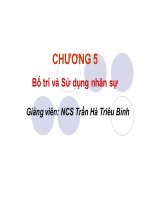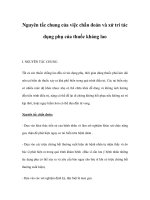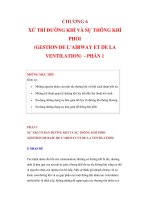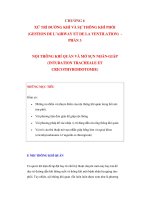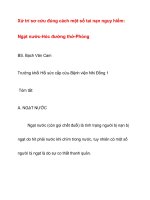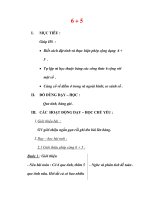Xử trí XUẤT HUYẾT TIÊU HÓA ở bệnh nhân đang dùng DAPT
Bạn đang xem bản rút gọn của tài liệu. Xem và tải ngay bản đầy đủ của tài liệu tại đây (610.4 KB, 41 trang )
Bệnh viện Đại học Y Dược TPHCM
Xử trí
XUẤT HUYẾT TIÊU HÓA
ở bệnh nhân đang dùng DAPT
Võ Thị Mỹ Dung
ĐHYD TPHCM
TP. Hồ Chí Minh, 02-11-2019
Nội dung
•
•
•
•
•
Đại cương
Đánh giá mức độ xuất huyết
Xử trí xuất huyết tiêu hóa (XHTH) trên
Dự phòng XHTH khi dùng DAPT
Kết luận
2
Đại cương
• Biến chứng xuất huyết (XH) có liên quan đến việc tăng
nguy cơ của những kết cuộc bất lợi tiếp theo, gồm MI, đột
quỵ, huyết khối stent và tử vong, ở bệnh nhân bị hội
chứng vành cấp (ACS) hoặc can thiệp mạch vành qua da
(PCI),1-6 và trong điều trị chống huyết khối lâu dài7,8
• Phòng ngừa XH nặng là quan trọng trong cải thiện kết
cuộc, tạo nên sự cân bằng giữa tính an toàn và tính hiệu
quả trong điều trị ACS
1.
2.
3.
4.
5.
6.
7.
8.
Eikelboom JW. Adverse impact of bleeding on prognosis in patients with ACS.
Rao SV. Impact of bleeding severity on clinical outcomes among patients with ACS.
Kinnaird TD. Incidence, predictors, and prognostic implications of bleeding and blood transfusion following PCI.
Kirtane AJ. Correlates of bleeding events among moderate- to high-risk patients undergoing PCI and treated with eptifibatide.
Manoukian SV. Impact of major bleeding on 30-day mortality and clinical outcomes in patients with ACS.
Moscucci M. Predictors of major bleeding in ACS.
Berger PB. Bleeding complications with DAPT among patients with stable vascular disease or risk factors for vascular disease.
Ducrocq G. Riskscore to predict serious bleeding in stable outpatients with or at risk of atherothrombosis.
3
Đại cương
• XH biến chứng thường gặp ở BN được điều trị
thuốc chống đông đường uống (OAC) và điều trị
kháng tiểu cầu, tỉ lệ chảy máu rõ # 5%/năm 1-8.
• Liệu pháp kháng tiểu cầu kép (DAPT), aspirin và
chất ức chế P2Y12, là nền tảng điều trị ở BN bị ACS
và PCI.
• DAPT có nguy cơ XH nhưng bảo vệ chống lại các
biến cố thiếu máu cục bộ. XH khi sử dụng DAPT là
một yếu tố dự đoán độc lập về kết cuộc lâu dài
1. Baber U. Use of prasugrel vs clopidogrel and outcomes in patients with ACS undergoing PCI in contemporary clinical practice. AHJ.
2017;188:73–81.
2. Proietti M. Time in therapeutic range and major adverse outcomes in atrial fibrillation patients undergoing PCI. AHJ. 2017;190:86–93.
3. Connolly SJ. Dabigatran versus warfarin in patients with atrial fibrillation. NEJM. 2009;361(12):1139–51.
4. Giugliano RP. Edoxaban versus warfarin in patients with atrial fibrillation. NEJM. 2013;369(22):2093–104.
5. Granger CB. Apixaban versus warfarin in patients with atrial fibrillation. NEJM. 2011;365(11):981–92.
6. Patel MR. Rivaroxaban versus warfarin in nonvalvular atrial fibrillation. NEJM. 2011;365(10):883–91.
7. Wiviott SD. Prasugrel versus clopidogrel in patients with ACS. NEJM. 2007;357(20):2001–15.
8. Wallentin L. Ticagrelor versus clopidogrel in patients with ACS. NEJM. 2009;361(11):1045–57.
4
Đại cương
• Tần suất của xuất huyết được báo cáo trong sổ bộ
ADAPT-DES là 6,2% sau trung bình 300 ngày theo
dõi sau xuất viện.1 Hầu như 2/3 các trường hợp
xuất huyết xảy ra từ đường tiêu hóa (GI). XHTH
ước tính xảy ra 1,2-2,4% bệnh nhân có can thiệp
mạch vành.2
• Xác định bệnh nhân có nguy cơ chảy máu cao hơn
trước can thiệp mạch vành có thể giúp giảm sự xuất
hiện của các biến chứng chảy máu.
1. Genereux P. Incidence, predictors and impact of post-discharge bleeding after percutaneous
coronary intervention. JACC 2015;66:1036–1045
2. Niteen V. Bleeding on dual antiplatelet therapy- real-life challenges. European Heart Journal 5
Supplements (2018)
Đánh giá mức độ xuất huyết
6
Bleeding Academic Research Consortium
Definition for Bleeding
• Type 0: no bleeding
• Type 1: XH không can thiệp và không khiến bệnh
nhân phải nhập viện hoặc điều trị
• Type 2: bất kỳ dấu hiệu XH nào, không phù hợp với
tiêu chí cho loại 3, 4 hoặc 5 nhưng không đáp ứng ít
nhất một trong số các tiêu chí sau:
(1) yêu cầu can thiệp nội khoa, không phẫu thuật
(2) nhập viện hoặc tăng mức độ chăm sóc, hoặc
(3) đánh giá ngay lập tức
Standardized bleeding definitions for cardiovascular clinical trials: a consensus report from the Bleeding 7
Academic Research Consortium 2011
Bleeding Academic Research Consortium
Definition for Bleeding
• Type 3:
3a:
− XH rõ kèm Hb từ 3 - <5 g / dL * (do XH)
− Truyền máu do XH
3b:
− XH rõ kèm Hb ≥5 g / dL * (do XH)
− Chèn ép tim
− XH cần can thiệp phẫu thuật (trừ nha/mũi/da/trĩ)
− Chảy máu cần dùng thuốc vận mạch tĩnh mạch
3c:
− XH nội sọ (không bao gồm chảy máu vi thể)
− XH nội nhãn
Standardized bleeding definitions for cardiovascular clinical trials: a consensus report from the Bleeding 8
Academic Research Consortium 2011
Bleeding Academic Research Consortium
Definition for Bleeding
• Type 4: XH liên quan ghép động mạch vành
– XH nội sọ trong vòng 48 giờ
– Mổ lại để kiểm soát XH sau khi đóng chỗ mở thông
xương ức
– Truyền ≥5 đv máu toàn phần, HC lắng trong 48 g.†
– Lượng ống ngực 2 lít trong 24 giờ
• Type 5:
− 5a: XH gây tử vong, không khám nghiệm tử thi
hoặc xác nhận hình ảnh
− 5b: XH gây tử vong, khám nghiệm tử thi hoặc xác
nhận hình ảnh
Standardized bleeding definitions for cardiovascular clinical trials: a consensus report from the Bleeding 9
Academic Research Consortium 2011
Etiology of GI bleeding by case control status
Etiology of GI bleeding in patients on DAPT. J Dig Dis. 2018
DAPT group
n (%)
Control group
n (%)
P value
Peptic ulcer disease
28 (24.6)
25 (21.9
0.8
Diverticular bleeding
14 (12.3)
16 (14)
0.9
Esophagitis/gastritis/duodenitis
13 (11.4)
10 (8.8)
0.8
Hemorrhoids
10 (8.8)
15 (13.2)
0.7
Varices
5 (4.4)
14 (12.3)
0.6
AVM
7 (6.1)
9 (7.9)
0.9
8 (7)
6 (5.3)
0.9
Colitis
6 (5.3)
6 (5.3)
1
Colon ulcer
4 (3.5)
2 (1.8)
0.9
Colon cancer
2 (1.8)
2 (1.8)
1
UGI polyp/cancer
1 (0.9)
3 (2.6)
Too few
Other
1 (0.9)
7 (6.1)
Too few
None
26 (22.8)
6 (5.3)
0.3
Etiology
Colon polyp
10
Mechanisms of upper GI bleeding induced by
NSAIDs, Low-dose Aspirin (LDA) or H.pylori infection
Non-variceal upper gastrointestinal bleeding.
2018 Macmillan Publishers Limited, part of Springer Nature
11
Complex pathophysiology of NVUGIB
Non-variceal upper gastrointestinal bleeding. 2018 Springer Nature
Risk factors
Comorbidities
Dysregulated processes
Gastrointestinal pathology
Vitamin K
antagonists
DOACs
P2Y12
antagonists
NSAIDs
Excessive
alcohol intake
Heavy meals
Angiodysplasia
Vascular lesions
Ischaemia
Fibrinoid necrosis
Degeneration
Inhibition of
coagulating factors
NVUGIB
Inhibition of platelet
activation
Mallory-Weiss
syndrome
Vomiting
Mucosal
damage
COX inhibition
Vascular damage
Genetic
predisposition
Chronic
hypoxia
Free radicals
Clotting
dysfunction
Altered
microperfusion
Systemic
inflammatory
status
Renal
insufficiency
Cardiovascular
disease
Pulmonary
insufficiency
Coagulopathy
Organ failure
Age
Inflammation
Virulence
factors
Immune response
cytokines
H.pylori
Previous inflammatory
conditions
12
Steroids
Non-selective
NSAIDs
COX2 inhibitors
CHẨN ĐOÁN MỨC ĐỘ XUẤT HUYẾT TIÊU HÓA
XHTH
nhẹ
trung bình
nặng
Máu mất
<1 L
1–2 L
2 L
Huyết áp
bình thường
giới hạn dưới bình
thường
hạ áp
Hạ áp tư thế
không
có thể
chắc chắn
Mạch nhanh
không
vừa phải
nhiều
Da
ấm,
tưới máu tốt
đổ mồ hôi
mát – lạnh,
ẩm ướt
Nhịp thở
bình thường
bình thường/ nhẹ
bất thường
Nước tiểu
bình thường
giảm
vô niệu
tỉnh/lo âu
lo âu
lẫn lộn/ngủ gà
Tri giác
Initial Management of Acute Upper Gastrointestinal Bleeding: From Initial Evaluation up to
13
Gastrointestinal Endoscopy – Cappell MS, Friedel D - Med Clin N Am 92 (2008) 491–509
Forest: khả năng chảy máu tái phát
Ia
máu đang phun ra
80–90%
Ib
máu đang rỉ ra
10–30%
IIa
lộ mạch
50-60%
IIb
cục máu đông bám
25-35%
IIc
cặn máu đen
0-8%
III
ổ loét đáy sạch
0-12%
14
Risk prediction using the Forrest classification
Klein A. Acute, nonvariceal upper gastrointestinal bleeding. Curr. Opin. Crit. Care 21, 154–162 (2015)
Endoscopic
stigmata
Risk of
persistent
bleeding or
Forrest rebleeding
without
endoscopic
treatment
Risk of rebleeding after
endoscopic
haemostasis
Risk of
needing
surgery for
bleeding
without
endoscopic
treatment
Risk of
mortality
without
endoscopic
treatment
Acute bleeding
Spurting
haemorrhage
Ia
Oozing
haemorrhage
Ib
Very high
High
High
Low
Very low
Signs of recent bleeding
Non-bleeding visible
vessel
Adherent clot
Flat pigmented spo
Iia
High
High
High
Low
IIb
High
Very low
Low
Low
IIc
Low
Not applicable
Very low
Very low
Not applicable
Extremely low
Very low
Lesion without active bleeding or signs of bleeding
Clean base
III
Very low
Xử trí
16
Management of Bleeding After Recent Stenting
General stages of bleeding management
1. Assessment of bleeding entity
2. Determination of hemodynamic/neurological
condition
3. Stabilization ― Anti-antithrombotic therapy (AAT)
4. Imaging of clinically suspected site of bleeding (SOB)
5. Local bleeding control if possible or specific
treatment of SOB ― blood transfusions
6. Consider bailout surgery
7. Resume DAPT as soon as possible
Restenosis, Stent Thrombosis, and Bleeding Complications. JACC, vol 71, I 15, April 2018
17
Management of Bleeding After Recent Stenting
Restenosis, Stent Thrombosis, and Bleeding Complications. JACC, vol 71, I 15, April 2018
Acute
bleeeding
Minor bleeeding
Do not
interrupt DAPT
Major bleeeding
Compress
mechanically
Suspicion intracranial hemorrhage
Hemodynamically unstable
Imaging of site of
bleeding (SOB)
Consider patient
admission
Neurologically unstable
Fliud resuscitation
± AAT
Patient
education
SBP ≥80
mm Hg
Imaging of clinically
suspected SOB
DAPT temporary
interruption
Specific SOB
treatment
Consider blood
transfusions
Ventilatory
support ± AAT
SBP <80 mmHg or
need for vasopresor
Urgent brain CT
Neurosurgical
evaluation
Clinically
suspected SOB
Intracardial bleeding/
Retroperineal hemorrhage
Endoscopic control/
Arterialembolization
Resume DAPT
if posible
Endovascular control
± pericardiocentesis
Bailout surgery
18
KEY MESSAGE
• Chảy máu nhẹ có thể tiếp tục sử dụng DAPT.
• Chảy máu vừa phải: cân nhắc ngừng DAPT và tiếp
tục điều trị kháng tiểu cầu đơn.
• Chảy máu nghiêm trọng: ngừng tất cả các loại thuốc
chống huyết khối.
• Nên khởi động lại liệu pháp chống huyết khối sau
khi bị chảy máu, ngoại trừ sau XH nội sọ thùy.
• DAPT nên được bắt đầu lại trong vòng ba ngày, nên
xem xét lại thời gian DAPT và chuyển từ ticagrelor /
prasugrel sang clopidogrel.
A practical guide on how to handle patients with bleeding events while on oral antithrombotic treatment.
19
Neth Heart J (2018) 26:341–351
Bleeding while using antiplatelet therapy
XH nhẹ
XH không đáng kể
XH trung bình
Tiếp tục DAPT
Cân nhắc rút
ngắn thời gian
DAPT hoặc
chuyển sang
thuốc ức chế ít
mạnh hơn P2Y12
Tiếp tục DAPT
Cân nhắc ngừng DAPT
và tiếp tục SAPT, tốt nhất
là với thuốc ức chế
P2Y12, đặc biệt trong
trường hợp XHTH trên
Sử dụng lại DAPT ngay
khi thấy an toàn, tốt nhất
Cân nhắc PPI tiêm mạch
là trong vòng 3 ngày
nếu XHTH trên
Cân nhắc rút ngắn thời
Phẫu thuật hoặc nội soi
gian DAPT hoặc chuyển
điều trị nguồn chảy máu
sang chất ức chế P2Y12
nếu có thể
ít mạnh hơn
Bù dịch
Cân nhắc truyền hồng
cầu nếu Hb <6 mmol/L
A practical guide on how to handle patients with bleeding events while on oral antithrombotic treatment.
20
Neth Heart J (2018) 26:341–351
Bleeding while using antiplatelet therapy
XH nặng
XH đe dọa tính mạng
Cân nhắc ngừng tất cả các
thuốc chống huyết khối
Khi XH ngừng, đánh giá lại nhu
cầu DAPT / SAPT
Nếu dùng lại DAPT, hãy xem xét
rút ngắn thời gian DAPT hoặc
chuyển sang các chất ức chế
P2Y12 ít mạnh hơn
Ngay lập tức ngừng tất cả các
thuốc chống huyết khối
Khi XH ngừng, đánh giá lại nhu
cầu DAPT / SAPT, tốt nhất là với
thuốc ức chế P2Y12, đặc biệt là
trong trường hợp XHTH trên
Cân nhắc PPI tiêm mạch nếu XHTH trên
Phẫu thuật hoặc nội soi điều trị nguồn chảy máu nếu có thể
Bù dịch
Cân nhắc truyền hồng cầu nếu Hb <6 mmol/L
A practical guide on how to handle patients with bleeding events while on oral antithrombotic treatment.
21
Neth Heart J (2018) 26:341–351
Management of NVUGIB
in those using antiplatelet agents
Non-variceal upper gastrointestinal bleeding. 2018 Springer Nature
NVUGIB in patients taking antiplatelet agents
High-risk stigmata on endoscopy
(Forrest Ia, Ib, IIa or IIb)
Low-risk stigmata on endoscopy
(Forrest IIc or III)
Successful endoscopic treatment
Antiplatelet agents for
primary prevention
Withhold antiplatelet agents
Re-evaluate indication
Reintroduce after ulcer
healing or earlier if needed
Resume
by day
3-5
Antiplatelet agents for
secondary prevention
Aspirin
DAPT
Second-look endoscopy at the
discretion of endoscopist or if rebleeding is suspected
Antiplatelet agents for
primary prevention
Antiplatelet agents for
secondary prevention
Withhold antiplatelet agents
Re-evaluate indication
Reintroduce before
discharge if indicated
Continue Aspirin
Consult cardiologist before restarting
additional antiplatelet agent
Continue
Aspirin or
DAPT
22
XHTH khi sử dụng liệu pháp kháng tiểu cầu
• ESGE và ESC, khuyên cáo sử dụng aspirin hoặc DAPT để
phòng ngừa thứ phát với XHTH trên, tiếp tục aspirin hoặc
DAPT nếu nội soi không có đang chảy máu [16,17]. Cân
nhắc ngừng aspirin 3 ngày nếu đang chảy máu khi nội soi;
nếu đang dùng DAPT, tiếp tục thuốc ức chế P2Y12 và ngừng
aspirin trong ba ngày [16,17].
• ACG, XHTH dưới cấp nên tiếp tục dùng aspirin [32]. bệnh
nhân đang DAPT, nên ngừng thuốc ức chế P2Y12 trong tối
đa 7 ngày, nên tiếp tục dùng aspirin. Nếu bệnh nhân bị ACS
trong vòng 90 ngày hoặc đặt stent mạch vành trong vòng 30
ngày thì nên tiếp tục DAPT [32].
• ESC DAPT khuyến cáo nên xem xét rút ngắn thời gian DAPT
và chuyển sang DAPT gồm aspirin với clopidogrel [11].
A practical guide on how to handle patients with bleeding events while on oral antithrombotic treatment.
23
Neth Heart J (2018) 26:341–351
XHTH khi sử dụng liệu pháp kháng tiểu cầu
• ESGE khuyến cáo những bệnh nhân bị XHTH trên,
bắt đầu ngay lập tức các thuốc ức chế bơm proton
(PPI) tiêm tĩnh mạch liều cao [17] và tiếp tục truyền
tĩnh mạch kéo dài 72 giờ sau nội soi [17]. PPI làm
giảm đáng kể nguy cơ XHTH trên ở những bệnh
nhân được điều trị bằng liệu pháp kháng tiểu cầu.
Nên tiếp tục PPI đường uống sau khi xuất viện khi
điều trị lại thuốc kháng tiểu cầu [11,16,33-35].
A practical guide on how to handle patients with bleeding events while on oral antithrombotic treatment.
24
Neth Heart J (2018) 26:341–351
Advice
• Ngừng OAC khi XHTH trung bình hoặc nặng [11,16,17].
• Khởi động lại OAC 7-15 ngày sau XHTH [17,21,30].
• BN có nguy cơ huyết khối cao (van tim cơ học, thiết bị
hỗ trợ tim) có thể có hưởng khi sử dụng lại trong tuần
đầu tiên [11,17].
• Cân nhắc sử dụng NOAC hoặc apixaban liều thấp ở
bệnh nhân XHTH do NOAC [12].
• Những bệnh nhân đang dùng aspirin hoặc DAPT, tiếp
tục dùng aspirin hoặc DAPT nếu nội soi thấy không có
đang chảy máu [16,17].
A practical guide on how to handle patients with bleeding events while on oral antithrombotic treatment.
25
Neth Heart J (2018) 26:341–351




